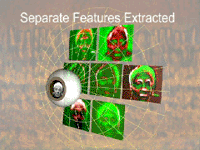 |
|
Neurobiologist
Frank Werblin, professor of molecular and cell biology,
UC Berkeley. Robert
Sanders photo
|
Berkeley
— The eye as a camera has been a powerful metaphor
for poets and scientists alike, implying that the eye provides
the brain with detailed snapshots that form the basis for
our rich experience of the world.
Recent
studies at the University of California, Berkeley, however,
show that the metaphor is more poetic than real. What the
eye sends to the brain are mere outlines of the visual world,
sketchy impressions that make our vivid visual experience
all the more amazing.
 Listen
to Frank Werblin
explaining the movie outputs of the eye (audio with photo).
Listen
to Frank Werblin
explaining the movie outputs of the eye (audio with photo).
"Even
though we think we see the world so fully, what we are receiving
is really just hints, edges in space and time," said
Frank S. Werblin, professor of molecular and cell biology
in the College of Letters & Science at UC Berkeley.
Werblin, a member of the Helen Wills Neuroscience Institute,
is part of UC Berkeley's Health Sciences Initiative, a collaboration
among researchers throughout the campus to tackle some of
today's major health problems.
The brain
interprets this sparse information, probably merging it
with images from memory, to create the world we know, he
said.
In a
paper in this week's issue of Nature, doctoral student Botond
Roska, M.D., and Werblin provide evidence for between 10
and 12 output channels from the eye to the brain, each carrying
a different, stripped-down representation of the visual
world.
 |
|
Seven
of the dozen separate movies that the eye extracts
from a scene and sends to the brain.
Frank
Werblin image
See
video page showing how
the eye processes images and sends them to the brain.
|
"These
12 pictures of the world constitute all the information
we will ever have about what's out there, and from these
12 pictures, which are so sparse, we reconstruct the richness
of the visual world," Werblin said. "I'm curious
how nature selected these 12 simple movies and how it can
be that they are sufficient to provide us with all the information
we seem to need."
While
scientists have known that the eye forwards several parallel
representations of the world to the brain, what these are
and how they are produced has been a mystery.
"What
we have done," Roska said, "is show that the retina
creates a stack of image representations, how these image
representations are formed and that they are the result
of cross-talk between layers of cells in the retina."
The results
are a big step toward producing a bionic eye employing a
unique computer chip that can be programmed to do visual
processing just like the retina. The chip, called a Cellular
Neural Network (CNN) Universal Machine, was invented in
1992 by Roska's father, Tamás Roska, and Leon O.
Chua, a professor of electrical engineering and computer
sciences at UC Berkeley.
"The
biology we are learning is going into improving the chip,
which is getting more and more similar to the mammalian
retina," Roska said. "Nevertheless, a bionic eye
is a far-fetched notion until someone figures out how to
connect it to the neural circuitry of the brain."